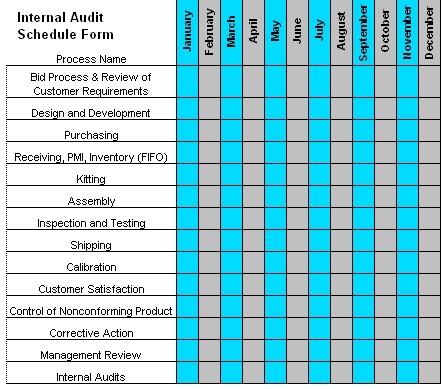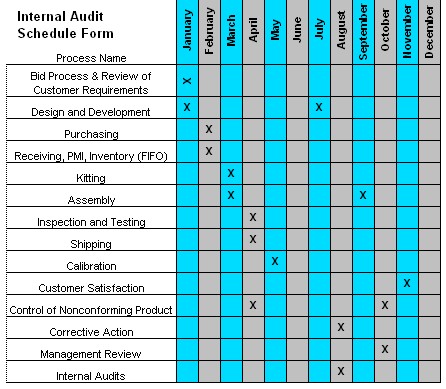The Internal Audit Schedule
While the ISO 9001 standard doesn't specifically require an internal audit schedule, it is the easiest way to keep your audit program on track. What the standard does require is that the audit program be planned.
The standard states that the audits will be administered with a plan to show that the QMS complies to the standard, complies to how the process was planned, and complies to any internal requirements your company established. This plan will consider the significance of the processes, their status and the previous audit results. This plan certainly sounds like it may need scheduling!
Once again, begin with your high level process interaction diagram (or the document created to comply with clause 4.1.b) where the processes and their interrelationships have been identified. This is the document that describes the processes to be audited.
Determine which of these processes are most important, In other words, which processes, should they have problems, will affect your customers the most. These are the processes that your company must make certain remain stable and consistent. Automatically schedule these key processes for additional audits, perhaps 2-3 times per year.
Now we can look at the rest of the processes and their audit results. Were any serious audit findings issued during the past year? Any findings classified as Major? Did any audit results show several Minor findings during the course of an audit? These processes are candidates for increased audit frequency.
Increasing the audit frequency is a question that should be answered within your audit results. But we'll cover that on the internal audit report page.
Looking for a public auditor training class?
View our Internal Quality Auditor Public Class Schedule
Attending our ISO9001:2008 Transition Webinar will help you begin your move to the revised ISO9001:2008 standard. Don't get needless findings in your surveillance audits!
Creating the Schedule
Develop a form that is suitable for your company. How frequently will audits be conducted? Monthly? Quarterly? You decide what works best for your organization. Auditing less frequently gives your company and its auditors more flexibility, but some organizations get careless with too much flexibility. Our example shows a monthly audit schedule.

Once the form is created it's time to schedule the audits. Key processes should have an increased audit frequency. From the example audit schedule, the organization determined that the Design and Development process,and the Assembly process were the key processes and as such, scheduled these processes for 2 audits per year. A review of past audit reports showed that the organization had issues with their Control of Nonconforming Product process. This also was given an increased audit frequency. The finished internal audit schedule is shown below.

All key internal processes are shown on the schedule. Again, the internal audit schedule must show that all processes your company has identified appear on the audit schedule. Notice that the example company chose not to include Training, Control of Documents, or Control of Records. Instead, they chose to audit these topics as support processes to every process on their schedule. Read more about support processes on the Internal Audit Checklist page.
Public Internal Auditor Classes only $450 per student!
View our Internal Quality Auditor Public Class Schedule




